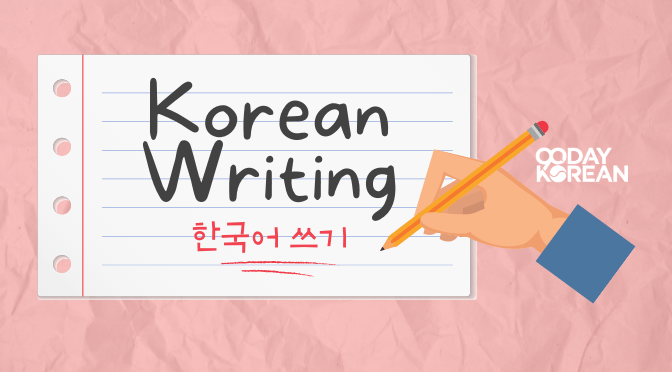Korean writing, at first glance, may appear to be similar to Chinese or Japanese, especially if this is a new language to you. But upon a closer look, especially with a piece of text in each language placed next to each other, it’s easy to see Korean is quite different.
Some may even be mind-blown when they realize that Korean isn’t written by characters but with their own alphabetic system. This can certainly gain one’s interest in how Korean writing works.
This article aims to offer you an overview of how to write words in Korean and, eventually, full sentences to help with your Korean fluency.
Below is a free PDF guide that you can download and take with you:
Introduction to the Korean writing system
Before we head on to the system of Korean writing, it’s best to take note of the following important points.
Chinese vs Japanese vs Korean writing
In a beginner’s eyes, writing systems look the same and can often be confusing to learn. The difference between Chinese, Japanese, and Korean writing can sometimes be hard to distinguish at first glance. Thankfully, compared to Japanese and Chinese, Korean is much easier to learn.
The Chinese writing system uses characters or a combination of writing systems. Similarly, the Japanese writing system uses Hiragana, Katakana, and Kanji. On the other hand, Korean has a set of alphabets they use for everything, and that’s it. It should only take you a few hours at most to learn and memorize each letter!
The Korean alphabet
The Korean alphabet is comprised of Hangul consonants and Korean vowels. There are 14 Korean consonants and 10 Korean vowels, plus some additional combinations.
If you’d like to know how to write Korean letters, you can start by learning the Korean alphabet together with us. You’ll also find a Korean Alphabet Chart in our article. This resource is helpful even if Korean is a new language to you. If you have to go check out the Korean alphabet article first, don’t fret – it only takes a little bit of your time to learn Hangeul, and then you can come back here!
Hangeul stroke order
If you’ve already concluded that step and learned about the stroke order, you can continue diving deeper into the Korean writing system.
As you learn Hangul, do take the time to learn the specific stroke order of each letter. After that, you’ll finally be ready to practice more aspects of the writing system with us in this article!
Hanja
South Korea also uses Chinese characters called hanja, but they are not used as widely. These Chinese characters have Korean pronunciations. You may want to learn them for fun, but they’re not essential for survival.
Korean syllable blocks
Writing in Korean is done through syllables. That means that while each Korean or Hangul alphabet is its own letter, none of them appear alone. Instead, two or more of the Korean alphabet letters are constructed into one block. Therefore, each Korean word also comprises one or more syllables.
Basic rules of forming Korean syllables
There are numerous ways each letter can be combined into a syllable. However, there are certain rules for constructing the letters within a syllable.
Start with a consonant
The first rule of thumb is that each syllable block begins with a consonant. This means that when the syllable technically only consists of a vowel, it gets combined together with the letter ㅇ, so the first letter is still a consonant—for example, the Korean vowel ㅏis not written as ㅏ but as 아.
Although the letter ㅇ normally has an “ng” sound, in these instances, it’s quiet and simply added there due to the Korean writing rules. Of course, no syllable can exist without at least one vowel included, either.
Consider the vowel placement
The way each syllable is constructed depends on the vowel used. If it’s a vertical vowel, in other words, ㅣ, ㅏ, ㅓ, and so on, then the initial consonant is placed on the left side of the vowel.
If the vowel is horizontal, so ㅜ, ㅡ, ㅗ, and so on, then the first consonant should be placed above the vowel. Additionally, it is possible to have one final consonant, two final consonants, or none. Below we have illustrated possible block combinations of syllables.
It is not formed in a horizontal line
To illustrate further, when you write using Latin characters and many otherworldly languages, you will simply place each letter in a sequence. Like this:
K + O + R + E + A = Korea.
However, in the Korean language, you will have to place them into specific blocks, which together then form the word.
So, in the case of the same word, but in Korean, it would look like this:
ㅎ + ㅏ + ㄴ ㄱ + ㅜ + ㄱ = 한국.
This is an excellent example of forming the block using both a vertical vowel and a horizontal vowel.
As you may notice, writing it as ㅎㅏㄴㄱㅜㄱ wouldn’t even make any sense. Therefore, using blocks to write comprehensively makes the most sense.
How to easily create Korean syllable blocks?
Now that we have covered the basic rules of writing syllables, it’s time to start looking at practical examples of them. By learning Korean and practicing this, you establish a great foundation of writing skills in Korean.
Step 1: Figure out which vowel you are using
As the vowel used in the syllable determines the placement of the Korean consonants, this is your starting point for building one. Are you using a horizontal or vertical vowel?
Step 2: Determine whether your syllable ends with a vowel or a consonant
If the syllable ends with a vowel, you will only need two letters to complete it. However, if you add one or two consonants after the vowel, you need to leave space for them below the first two letters in the syllable.
Step 3: Create the syllable block
Now that you have determined the ingredients of the syllable block, you can “fill in the blanks,” so to speak. Note that English and other language sounds are unreliable for telling you how each block should be formed. Hence, it’s best for you to master Korean pronunciation while forming syllables.
Korean writing practice with syllable blocks
Now that you know the rules for writing a word and have a step-by-step guide for creating them, it’s time to start your writing practice!
First and foremost, practice reading and writing syllables with only one consonant and vowel, as presented below. This is how Korean children learn to read and write, too.
| Initial Consonant | Syllables |
|---|---|
| ㄱ | 가갸거겨고교구규그기 |
| ㄴ | 나냐너녀노뇨누뉴느니 |
| ㄷ | 다댜더뎌도됴두듀드디 |
| ㄹ | 라랴러려로료루류르리 |
| ㅁ | 마먀머며모묘무뮤므미 |
| ㅂ | 바뱌버벼보뵤부뷰브비 |
| ㅅ | 사샤서셔소쇼수슈스시 |
| ㅇ | 아야어여오요우유으이 |
| ㅈ | 자쟈저져조죠주쥬즈지 |
| ㅊ | 차챠처쳐초쵸추츄츠치 |
| ㅋ | 카캬커켜코쿄쿠큐크키 |
| ㅌ | 타탸터텨토툐투튜트티 |
| ㅍ | 파퍄퍼펴포표 푸퓨프피 |
| ㅎ | 하햐허혀호효후휴흐히 |
Writing words with one syllable
Of course, many blocks of syllables include 3 or even 4 Korean letters. You can practice forming these blocks first for one-syllable words before moving on to more complex ones. Below are a few examples of their romanized Korean version.
| English | Hangeul syllables formed | Romanization |
|---|---|---|
| Rain | ㅂ + ㅣ = 비 | bi |
| Dog | ㄱ + ㅐ = 개 | gae |
| Second | ㅊ + ㅗ = 초 | cho |
| Door | ㅁ + ㅜ + ㄴ = 문 | mun |
| Horse | ㅁ + ㅏ + ㄹ = 말 | mal |
| Why | ㅇ + ㅙ = 왜 | wae |
| Leaf | ㅇ + ㅣ + ㅍ = 잎 | ip |
| Chicken | ㄷ + ㅏ + ㄹ + ㄱ = 닭 | dak |
In the case of the last word, 닭 (dak | chicken), you may have noticed we also come across some specific pronunciation rules. When there are two final consonants, one may become a silent one, as in this example.
However, the pronunciation also depends on which syllable follows it. Thus, depending on the word as a whole, the ㄱ may also become audible while ㄹ will become silent, or they may both get pronounced! You can start learning Korean pronunciation with our guide, which has been linked above.
Writing words with two or more syllables
Next, let’s go over some longer words for practice.
| English | Hangeul syllables formed | Romanization |
|---|---|---|
| Bedroom | ㅊ + ㅣ + ㅁ + ㅅ +ㅣ + ㄹ = 침실 | chimsil |
| Laptop | ㄴ + ㅗ + ㅌ + ㅡ + ㅂ + ㅜ + ㄱ = 노트북 | noteubuk |
| Penguin | ㅍ + ㅔ + ㄴ + ㄱ + ㅟ + ㄴ = 펜귄 | pengwin |
| To eat | ㅁ + ㅓ + ㄱ + ㄷ + ㅏ = 먹다 | meokda |
| To borrow | ㅂ + ㅣ + ㄹ + ㄹ + ㅣ + ㄷ + ㅏ = 빌리다 | billida |
| To prepare | ㅈ + ㅜ + ㄴ + ㅂ + ㅣ + ㅎ + ㅏ + ㄷ + ㅏ = 준비하다 | junbihada |
| To like | ㅈ + ㅗ + ㅎ + ㅇ + ㅏ + ㅎ + ㅏ + ㄷ + ㅏ = 좋아하다 | joahada |
| To dislike | ㅅ + ㅣ + ㄹ + ㅎ + ㅇ + ㅓ + ㅎ + ㅏ + ㄷ + ㅏ = 싫어하다 | sileohada |
By now, you should be properly familiar with the Korean alphabet letters and how to form syllables and Korean words. If you are also well-versed in pronouncing Korean words, then creating those syllables presented above should be easy.
Wrap Up
Now that you have better knowledge of writing in Korean, you can practice writing different words and even your Korean name! If you don’t have one yet, learn how to have your own Korean name through our full article about it here.
Next up on your road toward Korean fluency is writing practice on those Korean blocks! Perhaps you could do so with the help of our article on the most common Korean words and nouns? Also, let us know what you thought of the Korean way to construct syllable blocks in the comments!








Same question as I had before but with “ㄹ“ how will I know when it makes an “l” sound or an “r” sound? How can I tell?
Hi! The ㄹ is a unique sound. It’s not an R or an L exactly. It can be a range of sounds between R, L, or an R/L blend. Koreans don’t distinguish between R and L, it’s the same sound to them. Therefore, when you’re pronouncing the ㄹ, You can use R, L, or R/L.
How do I know when “ㄱ” will be pronounced with a “g” or a “k” sound? How can I tell?
The ㄱ can be a “G”, “K”, or a blend between the two. Korean sounds don’t match 100% with English sounds. A simple way to think of Korean letters is that they have sounds that are similar to some English sounds, but they have a range of sounds that can be produced. ^^
Also, when writing 소녀 (girl), can you write it as 소녀 and s ontop of o and n and then you with a O and then you? Does it matter which way?
Hi Roby! If you change the way it’s written, that means that it won’t be read as “girl”. For example, if you write 손여, it wouldn’t be read as “girl”.
Hi, I’ve been using Duolingo and the website to learn Hangul but there’s one thing I don’t understand. How do I know if the letters are going to be one on top of the other, 3 or 4?
서 (2) 삼 (3) 없 (4)
Hope this makes sense, thank you
When a syllable ends with a consonant, you would put the initial consonant and vowel on top of the final consonant. ^^
Hello i have read your note above but still i couldn’t understand is that
1) how do we write in hangul if consonant is followed by another consonant and not a vowel
2) how do we write in hangul if the vowel is followed by another vowel next to it
3) for example in writing paris pari in korean its written as 파리
Why i thought it would be 팔 ㅣ
4) how do u suggest to hold the writing system for one word with different hangul like for Key its 키 or 열 쇠 how should i learn that quickly
Thank you
Hi, If you are asking when writing English words into Korean, there are a few rule for them. If consonant is followed by another consonant and not a vowel, you can add ㅡ. e.g. desk-> 데스크. Korean letters always start with a consonant. And they can end with both a vowel or consonant. If the vowel is followed by another vowel next to it, you can add ㅇ. e.g. boy -> 보이, pari -> 파리 or 팔이. For words like 키 and 열쇠, you can use either one. There are many Korean words like that, so you can pick whichever is easier for you to learn. ^^